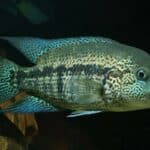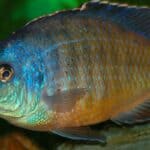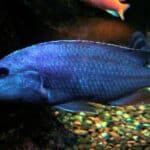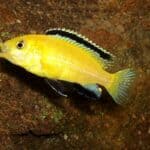The Jaguar Cichlid is a feisty freshwater fish. Their attractive appearance makes them very popular with home aquarists. Whilst this species poses a fun challenge for more experienced aquarists, they are not suitable for beginners.
If you want to find out more about this fascinating fish, or you are considering adding them to your own domestic aquarium, then keep reading! We will give you plenty of information on their tank requirements, behavioural traits, diet, breeding habits and more.

Species Summary
Jaguar Cichlids have a distinctive appearance and are known for their strong personalities. Originally from Central America, Jaguar Cichlids can be found in the lakes, rivers and ponds of Honduras, Nicaragua and Costa Rica.
The waters in their natural habitat are warm, neutral and quite murky. These fish are prone to aggression and can grow to quite a large size. They can be happy and healthy in a domestic environment if provided with the correct conditions.
Care Guide
Tank Size
Jaguar Cichlids require a minimum of 70 gallons per fully grown adult, but for optimum health and happiness it is recommended you provide them with 100 to 125 gallons of water. If housing a breeding pair, they will need at least 180 gallons of water.
Tank Mates
Jaguar Cichlid’s aggressive nature can make it hard to find them suitable tank mates. Stick with larger fish only, as the smaller ones are at risk of being eaten. Some possible options could be larger types of catfish and other kinds of cichlids.
But there is no guarantee that your Jaguar Cichlid will get on ‘swimmingly’ with their tank mates as this can depend on the temperament and personality of the individual fish.
Same Species Tanks
Jaguar Cichlids can live well together in bonded pairs if they have plenty of room, but this fish does do well in a small community of their own species.
Water Parameters
Whilst there are optimal conditions for the Jaguar Cichlid, they can survive at quite a wide range of water parameters. The temperature of the water can be anywhere between 73 to 82 degrees fahrenheit, but 75 to 77 degrees is the ideal range. The PH level of the water should be within 7.0 to 8.7, but 7.7 is optimum. The water hardness needs to be between 10 to 15 KH.
Nitrate and ammonia levels will need to be kept low, so a powerful water filter will be required. The water in their natural habitat has a fast flow, and a strong water pump will replicate this. They prefer dim or low lighting as this is similar to the murky waters of Central America.
What To Put In Their Tank
Jaguar Cichlids like to dig and disturb the substrate level, sometimes burying themselves, so sand is safer than gravel as it will stop them scratching themselves. To avoid plants being uprooted, choose floating vegetation or rooted plants that are secured with heavy pots. Driftwood, artificial caves and flat rocks can also be included in the tank, but be sure to avoid any rocks or gravel that are small enough to be swallowed.
Whilst it is important to use decorations to recreate the Jaguar Cichlids natural habitat, you shouldn’t over crowd the tank as they need plenty of space to swim around. Place most items around the perimeter of the tank with only a few pieces in the centre.
Common Diseases
Jaguar Cichlids are not susceptible to any particular diseases specific to their species. They are at risk of catching the same diseases and contagious water parasites as other fish in domestic freshwater aquariums, such as Ich and fin rot.
These issues are often caused by stress, but can also be a result of poor conditions or not maintaining the cleanliness of the tank.
Food & Diet
In the wild, Jaguar Cichlids are carnivorous. When raised in captivity they can be trained to eat flakes and pellets which include vegetation and algae, but it is important to ensure that their diet is rich in protein. A good diet can help to reduce displays of aggressive behaviour in this species.
Jaguar Cichlids will try and eat anything that will fit in their mouth, but the best things for them to eat are crayfish, prawns, krill, whitebait, insects, and worms. These fish need to be fed daily.
Lifespan
The average lifespan for Jaguar Cichlids is around 15 years, but this is dependent on many things. If the water parameters, tank conditions or diet are incorrect then this will dramatically reduce the lifespan of the fish.
Appearance
Jaguar Cichlids are quite large fish that are built for hunting. They have long oval-shaped bodies. With long fins supported by spiny rays. Other Cichlids have short stubby fins, but not Jaguar Cichlids. They have very prominent tail fins, dorsal fins and anal fins. These striking fins and spines create quite an intimidating appearance.
Jaguar Cichlids have large mouths which help them to catch their prey. Their lower jaws extend further than the upper jaw which helps with hunting and along their jaws are a set of sharp teeth.
A unique feature of Jaguar Cichlids is that their appearance and coloring changes with age. The juveniles of the species are pale gold or silver in color with large black stripes. Over time, the black stripes turn into spots to create the distinctive jaguar-like appearance.
Size
Jaguar Cichlids are a large species of fish. In the wild, they can reach lengths of up to 2 feet and some of them weigh more than 3 pounds. In a domestic tank, they are unlikely to grow more than 14 to 16 inches long.
Behaviour & Temperament
Jaguar Cichlids have a reputation for being aggressive and quite feisty! They are known for picking fights with other fish and will try to eat any fish smaller than them. Even mated pairs can be aggressive towards each other and need plenty of space.
Jaguar Cichlids are a very territorial species and will kill another fish over a territory dispute. Providing these fish with a good diet and optimal water conditions can help to reduce their aggressive behaviour, but a certain level of aggression is to be expected with this species. The juveniles of the species are less aggressive than adults.
These fish tend to occupy the bottom half of the tank, and are very active swimmers.
Breeding
Jaguar Cichlids naturally pair off into bonded pairs so they are not too difficult to breed. They are likely to become more aggressive during the mating cycle, especially towards other species in the tank, so it might be best to house the bonded pair in their own tank.
To help trigger the breeding process, you can raise the water temperature by a few degrees and perform regular 50% water changes. Feeding the Jaguar Cichlids with plenty of live food will also help to put the fish in the mood for mating.
When the female is ready to breed she will lay her eggs on a flat rock or in a cave. She will lay up to 2000 eggs which are orange in color. The male will then fertilize the eggs, which will hatch within 5-7 days. The female Jaguar Cichlid will guard the eggs closely while the male patrols the nearby area to protect her and their spawn. Both parents will fight other fish to the death to protect the eggs.
After the eggs hatch, the parents may dig a sand pit and transfer the smallfry there to keep a close eye on them as they grow. At 4 weeks old, the smallfry will be able to swim and will be big enough to eat baby shrimp, mosquito larvae and bloodworms. After 6 weeks, the parental care ends and the mating pair can rejoin the main tank.
Gender Differences: Male vs Female
There aren’t many significant differences between male and female Jaguar Cichlids. Males tend to be larger overall, and their tail fins, dorsal fins and anal fins are more prominent. Males are also known to be more colorful than females. Other features are the same for males and females.
Fun Facts
The lower jaw of the Jaguar Cichlid can protrude as much as 90% of the length of their mouth. This makes it very interesting to watch them while they are feeding.
These hardy fish can survive in temperatures of up to 97 degrees fahrenheit.








